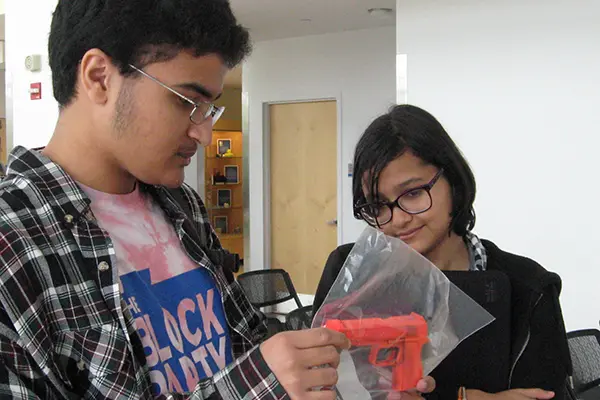“CSI: Lowell” Culminates in Short-story Contest
 Image by Katharine Webster
Image by Katharine Webster
10/26/2016
By Katharine Webster
Suspect No. 1 went to the hospital with a gunshot wound. She had paint chips on her clothing matching paint chips from the windowsill of the dead man’s home.
Suspect No. 2, the dead man’s live-in girlfriend, called 911 and told police she found her boyfriend’s body on the kitchen floor when she arrived home.
At the scene, police found a Glock 38 pistol, two spent cartridges, a piece of white cloth with a hair, black spots and a red stain — possibly blood — on it, a cell phone, prescription drugs and a brown bottle with traces of a deadly poison. Gunpowder residue on the dead man’s hand matched traces on the pistol grip and the black spots on the cloth.
So who killed him, and why?
That’s the question scientists at the university’s Core Research Facilities (CRF) are asking undergraduates to answer in a short-story contest after attending three “CSI: Lowell” lunchtime workshops about a fictional crime. The workshops are designed to showcase the state-of-the-art scientific instruments and capabilities CRF offers to students and faculty as well as corporate and government researchers who pay for instrument or lab use and services.
The “Lunch and Learn” series is being held this month at the Saab Emerging Technologies & Innovation Center for North Campus majors. The series will be repeated next month on South Campus for students in criminal justice and clinical lab sciences — and anyone else who’s interested in how forensic evidence is analyzed.
Sanskriti Sharma, a first-year computer engineering student from Mumbai, India, took detailed notes at the first session on analytical microscopy led by Earl Ada, manager of the Materials Characterization Lab.
 Image by Katharine Webster
Image by Katharine Webster
“I like writing and I like crime shows like ‘Bones,’” she said. “That’s why I’m here.”
Sharma plans to attend all three workshops and write a short story in hopes of winning the top prize, a $50 Starbucks gift card. The second and third sessions focus on analyzing poisons and prescription drugs and DNA. The “evidence” will be presented by Wendy Gavin and Jack Lepine of the Biomolecular Characterization and Nuclear Magnetic Resonance labs.
Adrien Nouvellon-Pugh, a first-year chemical engineering major from Arlington, attended because he took a high school class in biotechnology that included forensic analysis of hair and blood samples. The equipment at his high school was very basic compared to the scanning electron, ion beam, laser scanning and polarizing microscopes in the CRF.
“I thought it would be really cool to see how samples are analyzed in a real lab with high-quality equipment,” he said.
CRF is increasingly involving undergraduate students in its partnerships with companies. CRF has over 400 registered external users, from start-ups in the university’s M2D2 and iHub incubators to multi-national companies like Raytheon, MicroChem and General Dynamics, says director Theresa Hamelin.
Upper-class sciences and engineering students can participate in career co-ops and receive training by CRF staff on the equipment while working directly for companies paying for laboratory services, a unique partnership between CRF and the Career & Co-op Center. Some of the labs also offer work-study positions.
Faculty and graduate students also use CRF for their research. Lab managers not only train them on equipment, but help with experimental design and quality data collection.
Asst. Prof. Kwok-Fan Chow, who teaches Forensic Science, an advanced chemistry course, says his students really enjoyed the “CSI: Lowell” presentations.
“We are fortunate to have state-of-the-art instrumentation available at CRF for our students to use. Support from the friendly staff helps expose our forensics students to technologies and knowledge that they otherwise would not be able to experience,” he said.
In addition to the labs featured in the workshops, CRF also includes the NERVE Center — the robotics testing and experimentation facility — as well as the Thermal and Mechanical Properties, Nanomaterials Fabrication and Radiation labs.
